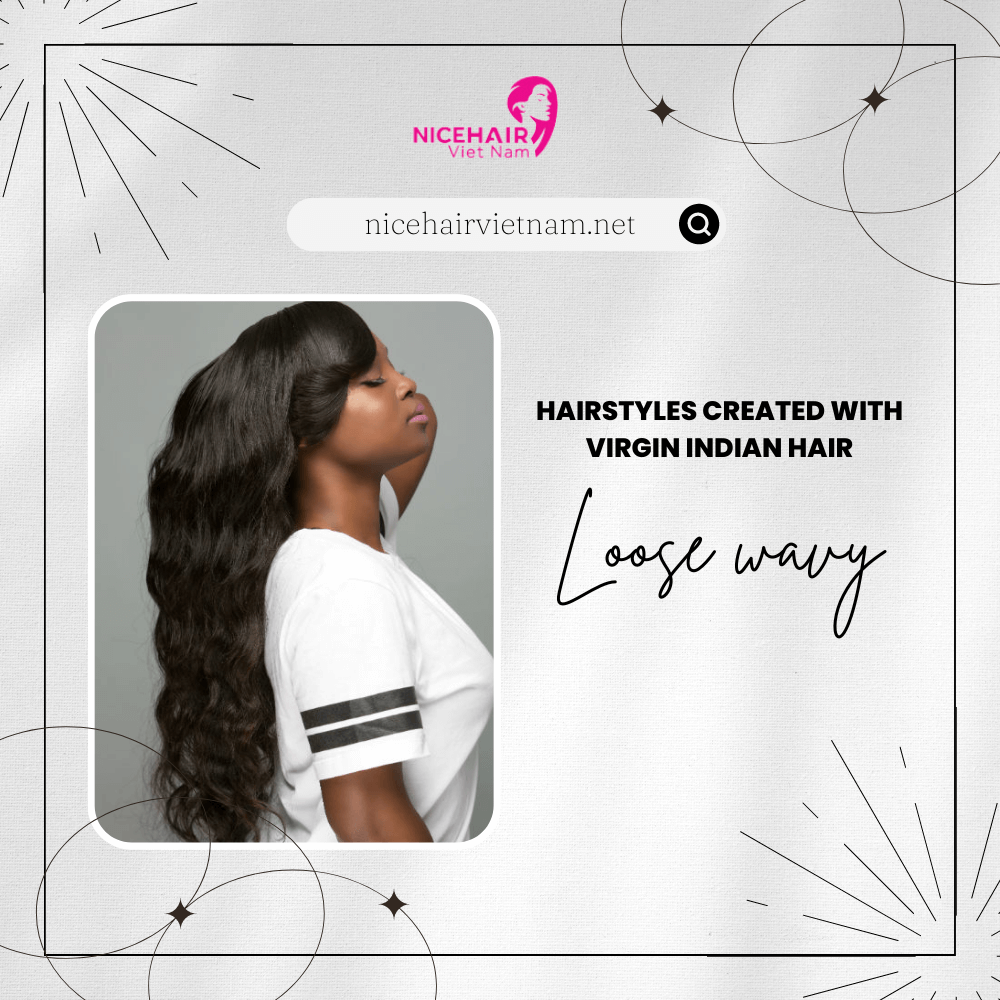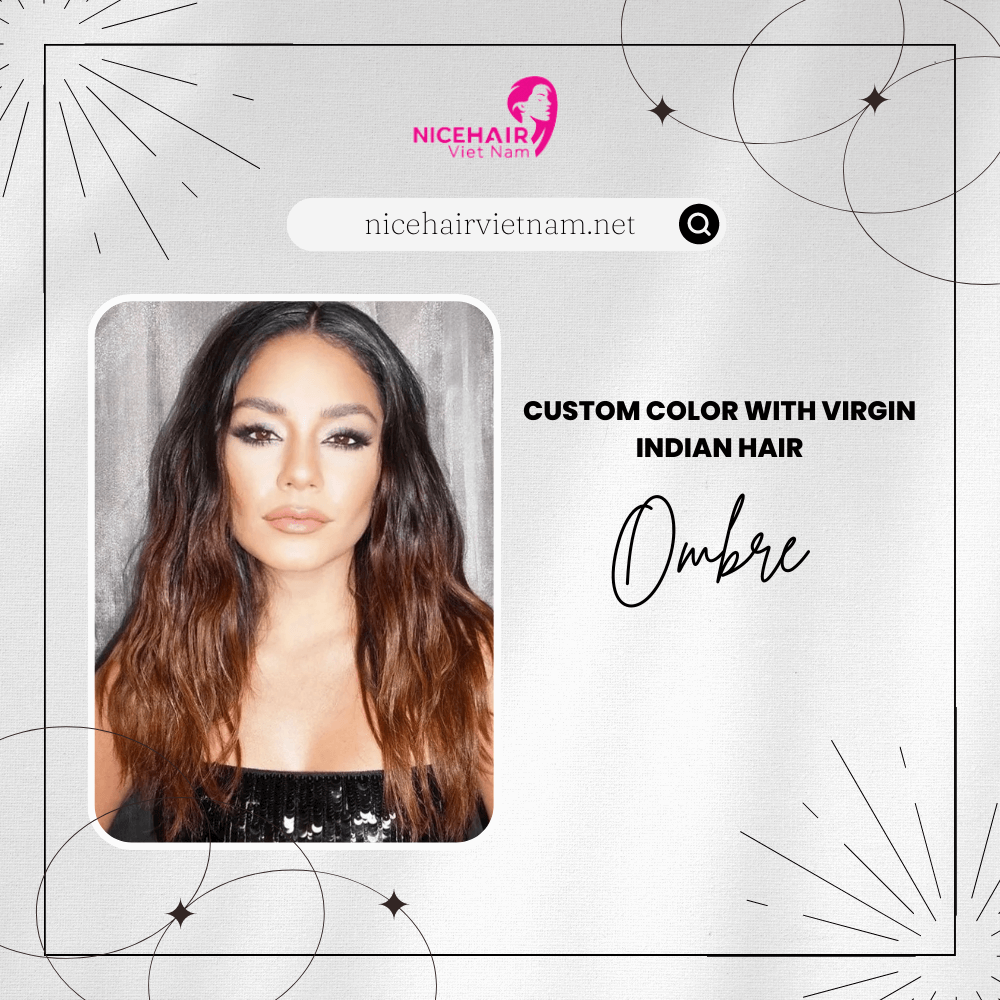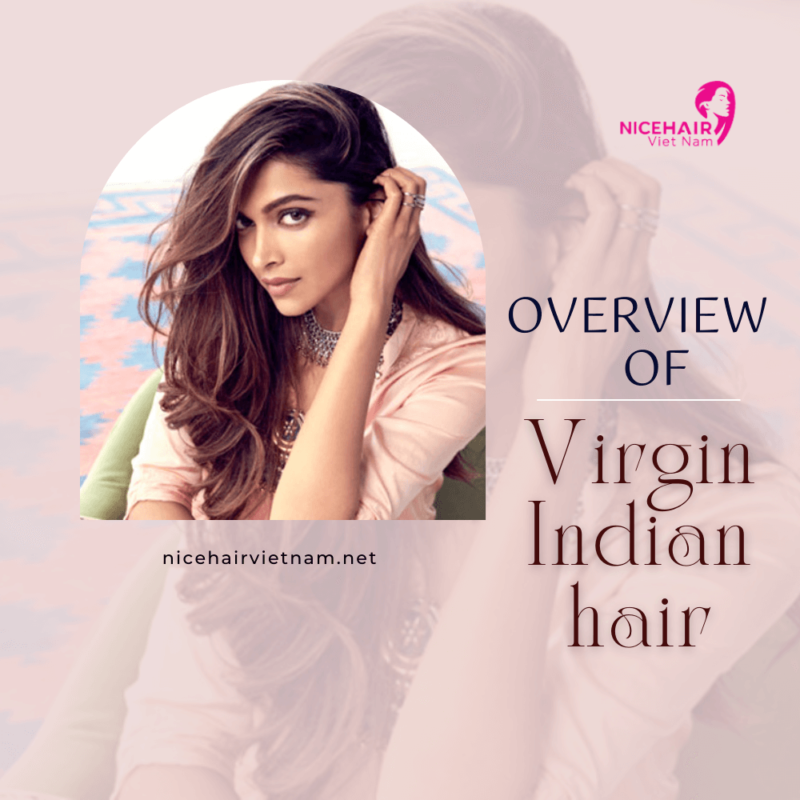Virgin Indian hair has emerged as one of the most readily available hair types. During the 1960s, when the United States implemented a ban on Chinese hair due to political tensions with China, virgin Indian hair gained popularity as a fashionable alternative. Consequently, the prohibition led to an increased prevalence of Indian hair in the market. And if you are interested in this topic, then let’s just follow this post which provides you an overview of virgin Indian hair in detail.
Basic information about virgin Indian hair
To start the overview of virgin Indian hair, first, you should understand what virgin Indian hair really is!
Definition
What is virgin Indian hair? Virgin Indian hair refers to hair sourced from India, specifically indicating that it originates from individuals of Indian descent. This type of hair is characterized by being 100% human hair that has never undergone any chemical treatments by manufacturers. The term “chemically unprocessed” implies that the hair has not been subjected to coloring, bleaching, or perming procedures that alter its natural color or texture. Hence, it is commonly referred to as unprocessed virgin Indian hair.
This meticulous approach to hair processing distinguishes it as the highest quality virgin Indian hair available in the market. The textures of Indian hair span a wide range, encompassing smooth straight strands to deeply curled patterns. While heat styling can be used to modify the curl patterns, the hair retains its “virgin” status due to the absence of chemical processing.
Features

Next in the overview of virgin Indian hair, we will get to know further the characteristics of this hair type, which will be illustrated below:
- Indian hair displays a captivating array of natural textures, ranging from delicate waves to incredibly tight curls. However, deeply curly Indian hair is a rarity and is seldom found in significant quantities. Therefore, if you desire bone straight hair or a specific curl pattern, you might encounter challenges in finding exactly what you’re seeking within the market.
- Regularly available variations of virgin Indian hair include natural straight, slightly wavy, naturally wavy, and curly hair, each showcasing a diverse range of curl tightness. While virgin Indian hair can be styled with curls or straightened using a flat iron to achieve your desired look, it offers a greater degree of versatility compared to other hair types.
- Since virgin Indian hair is never subjected to dyeing processes and is supplied in its natural state, it may exhibit slight color variations between bundles. This aspect, however, proves to be truly advantageous. Skilled hair stylists possess the expertise to seamlessly blend two bundles of hair, ensuring minimal color discrepancies. This meticulous blending technique not only enhances the realism of your hairstyle but also imparts a deeper and richer color, mirroring the natural multi-tonal variations found in our own hair.
Basic guidance on using
To ensure the longevity and impeccable appearance of your virgin Indian hair extensions, it is imperative to treat them with the same care and attention as you would your natural hair. By following proper maintenance practices in this overview of virgin Indian hair post, you can enjoy smooth, silky, tangle-free, and natural-looking hair for an extended period, allowing for multiple reuse. Let’s dive deeper this overview now!
- Regular brushing: is a vital step in maintaining your hair extensions. It is recommended to brush your hair extensions in the morning, starting from the ends and gradually working your way up to the scalp. This technique minimizes excessive tugging and reduces the risk of damage, thereby prolonging the lifespan of your extensions.
- Frequent washing and rinsing: particularly if you regularly use hair care products. While virgin Indian hair boasts a silky, natural texture and movement, the accumulation of deposits from styling products can impact its quality and disrupt its natural behavior. Heat treatments, in combination with product buildup, can lead to diminished hair quality, mirroring the effects on your own natural hair. Therefore, regular cleansing of your extensions is essential to maintain their original luster and ensure they retain their desirable characteristics.
Overview of pros and cons of virgin Indian hair
As customers explore the world of hair weaves and hair extensions, they are faced with a multitude of styles to choose from. However, determining the most suitable type of human hair weave can be a daunting task. What sets each variety apart? How can one ascertain whether virgin Indian hair is the right choice? Recognizing these concerns, overview of virgin Indian hair post is going to shed light on the advantages and disadvantages of virgin Indian hair.
Pros
- Virgin Indian hair stands out for its remarkable adaptability, inherent smoothness, and enviable glossiness. This sought-after hair type offers a diverse range of textures, including straight, curly, loose wave, natural wave, body wave, and deep wave. The beauty of virgin Indian hair lies in its ability to effortlessly embody these styles without the need for chemical treatments. This natural versatility allows for endless possibilities when it comes to hairstyling, ensuring that your locks will exude a captivating and authentic allure. Moreover, virgin Indian hair is exceptionally rare, making it a truly unique find.
- In addition to its aesthetic appeal, virgin Indian hair boasts impressive qualities that contribute to its desirability. Not only is it thick and lustrous, but it also exhibits exceptional resilience and flexibility. This means that you can style it to your heart’s content, and the hair will maintain its natural beauty with ease. Furthermore, due to its durability, virgin Indian hair extensions can be utilized for an extended period, offering longevity that can span up to an impressive 24 months.
- However, if budget constraints prevent you from investing in pricey human hair options, fear not, as economical alternatives such as virgin Indian hair extensions can readily serve as a suitable substitute. These extensions possess comparable features to European or Russian hair, allowing you to select between virgin Indian hair and other virgin hair options based on your budget and personal preferences. This flexibility empowers you to make a choice that aligns with both your financial considerations and individual style aspirations.
Cons
- The adaptability of virgin Indian hair extends to its ease of styling with flat irons and curling tools. This hair type effortlessly transforms, allowing you to achieve a sleek, straight look or bouncy curls according to your preference. However, it is important to note that in humid conditions, virgin Indian hair may be prone to frizz, necessitating the use of anti-frizz solutions to maintain a smooth and polished appearance.
- One unfortunate challenge in the hair industry is the misleading claims made by certain hair providers. While they may advertise their products as genuine virgin Indian hair, they may actually substitute it with lower-quality Chinese hair in order to increase their profit margins. These providers employ various tactics to give the appearance of smooth and tangle-free hair, but the true quality of the hair ultimately reveals itself after just a couple of washes. This presents a dilemma for those seeking to purchase hair online or even from local hair suppliers, as the deceptive practices employed make it difficult to ascertain the authenticity of the product. The hair may feel exceptionally silky when initially inspected, but its true nature becomes evident once it goes through the washing process.
Hence, it is crucial to exercise caution and conduct thorough research when purchasing virgin Indian hair to ensure that you are obtaining genuine, high-quality products. Seeking recommendations, reading customer reviews, and consulting trusted hair professionals can assist in making informed choices and avoiding potential disappointments. By taking these precautions, you can enhance the likelihood of acquiring true virgin Indian hair that lives up to its promised quality and longevity.
Overview of hair styling with virgin Indian hair
Virgin Indian hair is frequently thick yet lightweight, boasting a glossy and voluminous appearance. It is an excellent option for those who wish to alternate between wavy and straight hairstyles, as it can effortlessly achieve both looks. Additionally, virgin Indian hair offers versatility in creating a wide range of unique hairstyles. The quality of the virgin hair directly influences the vibrancy and richness of the resulting hair color. Follow this post of overview of virgin Indian hair to pick up certain skills!
Hairstyles created with virgin Indian hair

Virgin Indian hair is characterized by its natural thickness and straight texture. When air-dried, the hair forms gentle waves. The shades of Indian hair tend to be extremely dark, which complements straight and glossy styles beautifully. Due to its thick and coarse nature, Indian hair is easily straightened. However, if you desire hair with body and bounce, the extra-long lengths of Indian hair may not be the most suitable choice.
Unlike Vietnamese or Brazilian hair, Indian hair, being predominantly straight, does not hold curls as effectively. To create instant curls, you can lightly pat your Indian hair with a cloth. Another method is to braid the hair into a loose, wide braid at the nape of the neck, two pigtail braids, a ponytail, pin curls, or a wrap while it is still damp. This can be done before going to bed, and in the morning, the curls will last throughout the day. Foam curlers can also be used for quick and convenient curling, although they do not provide the same longevity as a curling iron.
When it comes to wavy hairstyles, virgin Indian hair offers options such as deep wavy, loose wavy, water curly, natural wavy, and more. The higher the quality of the hair, the more alluring and superior the resulting curls will be.
Custom color or bleaching

Virgin Indian hair can also be a suitable option for those with bleached or colored hair. When it comes to achieving the strongest and most vibrant hues, as well as consistent coloring, it is crucial to use hair extensions made from a single bundle of virgin hair. This ensures that the colors are intense and uniform. Hair shades like red, orange, purple, ombre, and various blended combinations are gaining popularity in contemporary hair trends. One way to determine if the hair is virgin Indian hair is by subjecting it to the bleaching process. Only virgin hair can be successfully bleached to achieve the most vibrant and striking colors.
While our virgin Indian hair extensions naturally come in black color, you may have the desire to experiment with different colors at home. In such cases, you can color the hair extensions. However, if your intention is to achieve a brilliant and lighter color, it is necessary to bleach the virgin Indian hair extensions beforehand. Opting to bleach the hair extensions yourself can be a more cost-effective and convenient approach when aiming for a lighter shade.
How to find good quality virgin Indian hair?
Without a doubt, virgin hair extensions are the greatest form of hair extensions. Virgin hair has not been treated or colored and is simply removed off the donor’s head and packed. Furthermore, virgin hair weaves are highly smooth, brilliant, and delicate. But do you know how to choose virgin Indian hair with good quality, let us show you the ways right in this section of the overview of virgin Indian hair.
Through visual
High-quality virgin Indian hair is characterized by its dark color and natural susceptibility to frizz in humid conditions. With proper care, these extensions will maintain their smooth and silky texture throughout their lifespan.
When it comes to hair extensions, the length is a crucial consideration. If you don’t specifically desire long hair, you can choose virgin Indian hair extensions of any length and have them trimmed to your desired specifications. Additionally, the cuticles of the virgin Indian hair all align in the same direction, from root to tip, ensuring a more natural and seamless blend.
For those seeking glossy and straight hairstyles, virgin Indian hair is an ideal choice. When straightened, the hair exudes a beautiful shine. The coarse and thick nature of the hair contributes to its ability to hold straight styles effectively. Additionally, virgin Indian hair is predominantly available in dark colors and often comes in exceptionally long lengths.
Through tactile sensation
As previously mentioned in the above part of the overview, the presence of cuticles is an essential characteristic of 100% virgin Indian hair. These cuticles should naturally run in the same direction, from root to tip. To determine the authenticity of the hair, you can perform a hair check technique that only experienced individuals in the hair industry are familiar with.
Start by running your finger along the length of the hair. You should feel smoothness as you move downward, but there should be some resistance or texture when you run your palm upward along the hair shaft. This indicates the presence of intact cuticles.
Another method involves softly placing a bundle of virgin hair over the skin of your hand. If the hair glides smoothly, softly, and coolly through your hand, it is likely authentic virgin Indian hair. On the other hand, if you run your finger through the hair and it falls gently without getting stuck in one spot, it indicates healthy hair. Additionally, this method can also help you determine if the hair is remy (cuticles intact and aligned) or non-remy.

